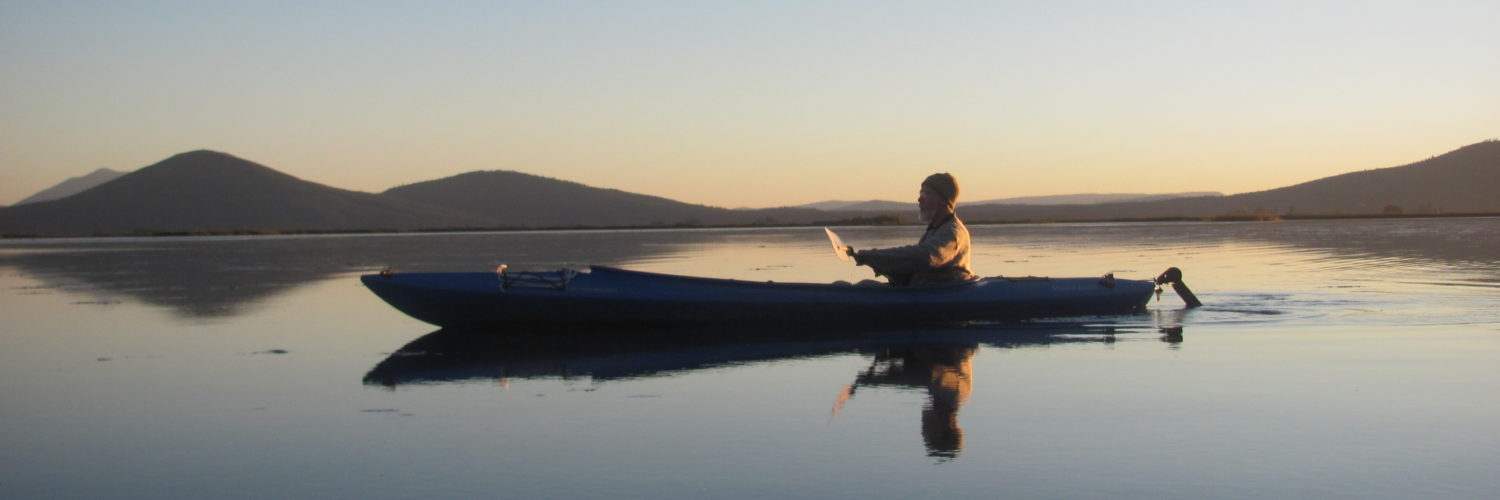Moving a Boulder
An old ranch road traverses the upper regions of this area’s watershed. Its ruts capture many small drainages coming down the slope and gather all of their runoff onto the road where the runoff flows quickly towards the main drainages of the area.
I look for places to lead this runoff out of the ruts, onto the slopes below where it can spread out and slow down. But it is hard to find these places. The road was formed by a small grader that scraped the rocks and dirt off the roadway to create a berm defining the downhill side of the road. In the backbone of this berm are two-foot boulders that I can’t move. I found one likely spot where I could at least open a narrow channel between two large boulders but I couldn’t move the boulders. So I went back another day with a crowbar, expecting that with its help, I would easily pry the boulder out of place. But I couldn’t. The center of gravity of the boulder was down too deep; I could only lift it up an inch. No matter what angle or position I tried, the crowbar could lift it only an inch. I didn’t expect that; that stopped me for a while.
 Looking downslope from the road. Crowbar is sticking up in front of the boulder.
Looking downslope from the road. Crowbar is sticking up in front of the boulder.
Eventually, I realized the problem. I was trying to move it out with one pry. I gathered smaller stones. I pried up the boulder and slipped one rock under where ever I could. Now the boulder couldn’t drop all the way back down which allowed me to slide the crowbar a bit further under it.
 I lifted it again, slid a second rock under the other side, and let the boulder settle down upon these two rocks. Now I could slide the crowbar in further which allowed me to lift the boulder higher than I had been able to before. I pushed the two rocks in further, preventing the boulder from settling down as much.
I lifted it again, slid a second rock under the other side, and let the boulder settle down upon these two rocks. Now I could slide the crowbar in further which allowed me to lift the boulder higher than I had been able to before. I pushed the two rocks in further, preventing the boulder from settling down as much.
I moved around the boulder, prying it up from different angles and slipping small rocks under that side until the boulder’s center of gravity was above the mire it had been sunk in.
 Then with just my hands, I was able to roll the boulder out of the berm.
Then with just my hands, I was able to roll the boulder out of the berm.
This gradual process felt like a metaphor for how small changes can accumulate into a large change that was impossible before.
Each time I return on later rain walks, I check out the play for the smile it inspires in me. That play is leading a significant amount of water off the rutted road back onto the gentle slope below. What is amazing me is how quickly that stream of water is absorbed into that slope. After a month with 13 inches of rain at home, the water flowing through that opening spreads out and flows for only about 20 yards until it has all been absorbed into the soil. That soil was thirsty!
Formerly it would have flowed along the ruts to the main drainage and probably have reached the Sacramento River within an hour. Now it is settling in, going to ground, a mile upslope of the river. Ever since this dirt road was graded decades ago, this downslope area has been deprived of the small flows of runoff that the road ruts have shunted away. Now it is receiving runoff once again. In terms of my metaphysics (Cairns 83), I see this play as creating possibilities. Runoff that previously contributed exponentially to erosion, carrying soil particles to a lower energy state, now will rise up through the plants back into the sky to fall again. On its upward way, it will fuel photosynthesis that will create more plant surface area, allowing that area to absorb more solar energy into the biosphere so that more possibilities will come into existence. I am curious to see what will emerge in this area in response to my play.
Negative Stream Orders
Back in college, I fell in love with stream orders in my Geology 101 course. Stream order is a way to mathematically organize the dynamic changes within a watershed of converging drainages. (The dynamics they reveal underlie my adage of “Go high in the drainage. Up there you will find a place within your power to shift a relative balance.”) First order streams are the smallest streams near the head of a drainage. When two first order streams converge, they form a second order stream. When two second order streams converge, they form a third order stream and so on. However, when something like a first order stream converges with a second order stream, the second order stream remains a second order stream. Only when two streams of the same order converge does the order number go up. With this system, it is possible to use stream order as the x-axis to graphically organize a lot of watershed data. As one moves downstream:
the stream order increases
there are less and less streams of the higher order
the distance until converging with a same-order stream grows longer
the amount of water flowing in the stream (its discharge) increases
steams, after a storm, take longer to crest.
the stream gradient becomes less steep
This way of organizing one’s analysis depends on what one classifies as a first order stream. All the higher orders are built upon that. I think I have a pretty good idea of how a hydrologist would classify the streams within the area I work. If I locked their classification in place, then the flows of runoff I am playing with during a storm when runoff is maximum would have a classification more like -1 or -2. Seeps that converge together to form rivulets that converge together to form streamlets.
Extending the x-axis into the negative realm gets interesting because the y-axes tend to be logarithmic. You can see some representative graphs at the bottom of this page on the internet. (http://www.s-cool.co.uk/a-level/geography/river-profiles/revise-it/drainage-basins)
Notice that the y-axes does not go up by steady units. It’s going up by multiples of ten (1, 10, 100). Extending the graph to the left, out beyond the y-axis to a -2 stream order would extrapolate the graphed line up to around 1000 -2 order streamlets within the area. A first order stream already has a lot of kinetic energy and is hard for one person to work with. But -2 order streamlets are easy to work with and they offer a thousand opportunities in an area where, if one focused on first order streams, one would face forty frustrating challenges that require more massive intervention than one person can achieve. This is because one runs out of space as one moves downstream. Up high in the drainage, there is lots of space off to the side to lead excess runoff but by the time the water is down into the channel of a first order stream, the shape of the land tends to funnel the water. Changing the dynamics of the water becomes a significant challenge.
When I go walking in the rain, I soon realize that almost the entire watershed is composed of -2 drainage basins. The large streams capture the attention but the watershed lies upstream of them. This reminds me of an observation about how our culture opted for fish hatcheries over healthy streams because fish hatcheries only require a few acres of technological wonder while a healthy watershed for fish requires tens of thousands of acres to be left intact. The fish hatchery “mitigates”, allowing the conversion of those tens of thousands of acres to some other economic use. Thinking of this led me to think about how, in an intact salmon watershed, tons of nutrients from the sea are defecated throughout the watershed to nourish future growth. The carcasses from our local hatchery, however, go to pet food, much of which might end up in poop scoop bags in our landfills. No poetry in that.
Concerning Charter Schools
A New York Times article about a charter school controversy with special education elicited hundreds of reader comments. Many of the comments coalesced into three criticisms of charter schools: charter schools don’t teach all kids; charter schools violate special education law; charter schools are being used to bust the teachers’ union and allow a corporate privatization of public education. Chrysalis gives me an “in the trenches” perspective on these three criticisms that I share below.
Charter schools don’t teach all kids, only those who apply to them
True. For me, that is the heart of why charter schools are such a wonderful idea! I have watched too many educational reforms be pushed from the top down to all schools, all teachers, all students. This top-down push is coordinated with standards, frameworks, new textbooks, new tests and funding for teacher inservices. It’s part of the “business” of public education – meaning much money is spent, much money is earned by those involved. And within two years of the push, the reform is grinding to a stop – opposed by parents who don’t want their children to be “guinea pigs”, who want their children taught the former way. It doesn’t make any difference if the reform is conservative or liberal; it will be opposed by some because it is imposed on all.
That was the genius of charter schools. Let’s create a place for small-scale experimentation, a place where people with ideas can try them out. However, since they are experimental ideas, participants have to give their “informed consent”. The family has to actively opt-in to the experiment; they have to apply to the charter school which has to declare its experimental intentions within a charter that is publicly available. The fact that charter schools teach only those families that apply to them is an “of course”. What would opponents propose instead? That families are enrolled in charter schools against their will? If we want to create opportunities for public education to evolve within the evolving culture, we must create opportunities for small-scale change (similar to my lifting up of the boulder).
One consequence of this “opt-in” approach to experimental evolution is that charter schools will have only families that have gone out of their way to research options and submitted applications. This skews the population in an important way. Kids whose parents are involved in their education tend to do better in school. So this should make charter schools “perform better” than traditional schools.
But this shouldn’t be accepted as a criticism of charter schools. It is simply a consequence of creating a more viable path for creating innovation than top-down impositions. But it does have two implications. First, it means that charter schools had better “perform better”, that “performing better” might have nothing to do with the actual program of the charter school and might be due to a skewed sample size. It is not legitimate for a charter school to say that their program is “better” than other schools just because of higher test scores. (In fact I shy away from any comparisons with other schools. I prefer to focus on specific stories that arise from my experiences, pointing out things that are or are not working for us – so that others can learn from our experiment.)
This leads to the second interesting implication. Apparently, many charter schools are not performing significantly better than their traditional counterparts as measured by test scores. However, families keep applying to these charter schools. Why? I would hypothesize that it is because those families are evaluating the school by a different measure than test scores. As I have mentioned before, resource agencies that try managing their resource by a single measure find that, invisible to their measure, their single-measure management is making the resource “brittle.” Similarly, our public schools have allowed test scores to dominate their management. Examining why families continue applying to the charter schools can shed light on possible problems beyond the measure of test scores. For example, several families whose kids transferred to Chrysalis from other schools would say that the reason they love Chrysalis is because “I feel like I have my child back again.” The kids would say that they feel free to be themselves at Chrysalis. What is that about? What was happening at the test-managed schools? These other factors that are hard to quantify need to be taken into account by anyone intending to comparatively assess different schools.
In conclusion, the genius of charter schools was to move reform out of the imposition from above, one size to fit all students and teachers. Let experimental reform start small with a school that embraces the idea and teaches it to those students whose parents have knowingly chosen that school with its approach. If the idea works, other families might also choose it, which will lead other teachers and schools to experiment with the idea.
Because of my admiration for this original intent, I laugh ironically when charter schools are now criticized because they don’t teach all kids. That was part of the original point. The critics want to paint the charter schools into the same corner public education keeps painting itself into. “Use this new educational approach on families that don’t want that approach used on their children.”
Charter schools violate special education law.
I can understand the possibilities that some charter schools might discriminate against special education students. The federal government underfunds its enforceable special education mandates and the federal No Child Left Behind required that 100% of special education students in a school would be proficient at grade level. If not, that school will be labeled a failing school and subject to take over. That 100% requirement is absurd, especially for special education. I remember one student who had been bright and cheerful as a young child who then got encephalitis. Though she survived, her math sense thereafter was only a shadow of what it had been before. She was never going to be proficient. And, for these same reasons, a district superintendent or principal might be tempted to suggest to the parents of a low-scoring student that they might want to transfer out of the regular school over to a charter school because it is smaller and might better serve their child. So special education is a messy area for all of public education and with the fading out of NCLB, hopefully the area will grow less messy.
However, there is another part of special education that makes it potentially messy for charter schools. Special education is the most top-down, mandated, recipe-driven part of public education I’ve encountered. What drives it is not the needs of the child but case law driven by special education lawyers bringing cases to keep expanding the interpretation of that case law. Special education is an area where families can bring a suit against a school and encumber the school’s general education budget with compensation and lawyer fees. If a suit is brought, much of the case depends on the school’s paperwork so paperwork plays a central role in special education. Hours are spent documenting meetings and services. Much of it is defensive, “just in case.”
Most of the case law has arisen within traditional schools and so the case law tends to prescribe traditional school solutions for everybody. The most significant example of this for Chrysalis is grade-level instruction. Special education law requires that a child with an IEP receive grade-level instruction. This arose out of cases where schools were parking some of their special education students on hold and not really teaching them – so I understand the intent behind the requirement of grade-level instruction. But Chrysalis questions the assumption underlying standards-based grade-level instruction as a way of organizing a school. Age should not be the determinant of what content a kid should be “fed” so that all kids of the same age receive the same fare. Our field studies, our camping trips are not found in state standards. The freedom of a teacher to swerve off-topic in response to an opportunity can lead to learning that is not in the state standards. The more rigid one becomes to state standards, the less creative freedom a teacher and his/her students experience and “learning” loses its zesty edge. For us, the emotional/cognitive experience of the learning is more important than the specific content because the learning experience is going to shape the neuronal networking that develops from the lesson. Therefore we resist all attempts to force us into the box of grade-level standards – for any student – as a model for how the teacher’s interaction should progress. But our dedication to this model can run us into conflicts with special education law.
Therefore, I pause before reading an article about charter schools and special education. I summon enough detachment to stay aware that there will be two sides to this story and that the charter school side might involve foundational issues beyond the details of the specific child and that article.
Charter schools are being used to bust the teachers’ union and allow a corporate privatization of public education.
Unfortunately, this is a legitimate concern, especially if legislatures start favoring or requiring charter schools to be capable of being “scaled up.” But here I just want to comment on the role of the teachers’ union. I believe that the union has allowed its role of collective bargaining to lock it into an “adversarial” relationship with the administration rather than evolving beyond that towards teacher-control of the schools. Though the union will criticize administration, the unions need the administration in order to justify the union’s primary role in collective bargaining. Moving beyond that to where the teachers actually run the school with assistance from administrative support (like in other professions) will require the unions to move beyond collective bargaining which, currently, is their main justification for existing.
There are messy issues involved in such a development but those are the issues that the union should be exploring. One issue that teacher power brings up is how teachers are hired. At Chrysalis, teachers watch candidates do an actual lesson with our students and then actively discuss which candidate is best. We view this power as fundamental to a teacher-led school and take it very seriously. The current union stance is a teacher with higher seniority within the larger district has priority over someone with less seniority. But if a group of teachers organizes a school with a special emphasis, should skills and enthusiasm related to that special emphasis trump seniority?
Another issue is setting salaries. Salaries are part of a larger budget. Teacher powered schools I’m familiar with tend to have smaller class sizes, more aides, better resources. This leaves less money for teacher salaries. But it allows one’s teaching to be more effective and hence more meaningful and joyous. That is what attracted teachers to the profession and that is what they navigate by when given the power.



Leave a Reply